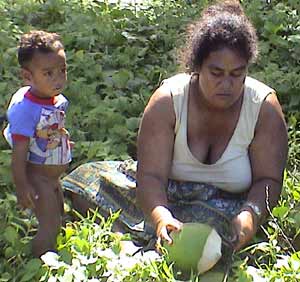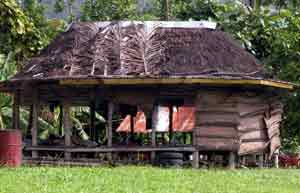North Tonga and Samoa

NORDLYS
David and Annette Ridout
Tue 29 Jun 2004 22:31
|
Final days in Niuatupotapu and onwards to
Samoa
Samoa
29th June 2004
It is 0815hrs on a lovely morning. Nordlys is
swinging at her anchor along with some 6 other yachts in Apia harbour. The
strains of a brass band are wafting across the water as the Samoan Police
Force march on their morning parade.
Our time in Tonga's most northern island was a
great success. This small community of some 800 people is now very cut
off. There have been no aircraft since January, although the airfield
grass is kept well cut. Four ferries a year come to the island.
There is no doctor although the midwife/nurse was a very competent
woman. The reason we know this is that Jago and Claire went and saw her
and offered to do a clinic for her. This offer was warmly received and
they went visiting to an old lady with diabetes and the following day did a
clinic in one of the villages. Jago came back with a big grin as he had
done a baby check on a four day old child who had proved to be very
healthy. Just like his grandfather who was also a GP he enjoys the baby
side of medicine very much. Apparently diabetes is a big problem amongst
the elderly. The hospital has no fridge due to lack of regular electricity
and so keeping insulin is impossible. However Jago was impressed by the
number of modern drugs that the nurse did have. She is also in regular
telephone contact with the main hospital in Nuku'alofa.
We ourselves went on a long walk to the windward
side of the island. Here there were many shells to be collected and as we
arrived down a lane through a coconut plantation we met a local family fishing
on the reef. The mother, a very big lady, was only too happy
to accept a lipstick thoughtfully brought by Kitty and Simon our friends on
Duet. She then proceeded to send her ten year old son up a palm tree to
fetch down the fruit. We were thus supplied with fresh coconut water
to quench our thirsts. Watching mother feed her other two year
old son with the water was quite a sight. The strength of the
prepuberty child was amazing. I wonder how many of the lads of ten in the
UK could climb thirty or so feet up a palm tree trunk, hold on with one had
and then spend some five minutes shaking off the coconuts with the other
hand? In my era at school when games and hours spent
in the gym were much more frequent than in most schools today we would have been
well through our teens before such strength was available to most of
us.
The 190 miles to Apia on Upolu, the main island of
independent Samoa was achieved by a days sailing followed by a night then a
morning beating up the northern coast. The fist day was actually a very
enjoyable if brisk close reach, the night was for the last six
hours very hard work as the wind constantly came and went and changed direction
hugely. For much of this period it rained heavily. The whole
exercise was achieved by Annette and myself as the youngsters retired to bed
feeling off colour. They are good company but not offshore
material!
Samoa like many of the Polynesian islands is full
of contrasts. Smiling happy people, a lot of near poverty especially in
the countryside. Apparent order but we understand lots of corruption
amongst the higher officials. Both Marriott and Sheraton gave up trying to
set up hotels here. Nature has not been kind to these people. In the
first decade of the twentieth century the island of Savaii was almost destroyed
by huge lava flows over its north coast. More recently hurricanes have
destroyed the cocoa and coffee crops while an infestation killed the
taro crop. Both big exports. We understand the islands survive on
loans and hand outs by the international community. As in so many of these
islands many of the inhabitants have emigrated to New Zealand, Australia and
other areas of apparent affluence. Driving around the island one is
constantly aware that village life is very much to the fore and their houses are
unique. These Fale as they are called are open buildings with either mats
or more often nowadays plastic used as protecting walls. The original
roofs were palm fronds but nowadays corrugated iron is to the fore.
Religion is big here and every village has at least two and often more
churches. The Church of the Later Day Saints has poured in money and there
are many types of Protestant Churches plus of course the Catholic
churches. I cannot help but wonder whether if some of this money had been
put to more productive uses the communities would not thrive a bit more.
Having said that it is obvious that they are proud of their churches and seem to
accept the difference in wealth between themselves and their
religion.
Lots of exercise has been taken while we have been
here as yesterday we climbed/walked for over two hours through jungle on a
track that was at times nearly vertical and was always wet and greasy
clay. For much of this way the ground was nearly invisible. Our
destination was a lake in the middle of the island that is so deep the German
Colonists were unable to find the bottom of. It is in fact a crater lake
famed for its population of goldfish. We saw one five inch
specimen. Today we have been to visit Vailima, The last house of
R.L.Stevenson. A magnificent old colonial building that is now
a well kept museum. Annette and I walked for an hour up the hillside to
his grave. This is on the top of the nearby mountain and our muscles were
aching by the time we got there.
So life on Nordlys goes happily by. One
advantage (?) of having visitors is that one tends to do more. I for one
will be happy to be back to a more tropical pace. We will set
sail in a couple of days the final forty miles, downwind, with Jago and Claire
on board to the island of Savaii. Hopefully we will catch some fish and
enjoy a few days swimming and snorkelling/diving on this lovely island
before Jago and Claire leave us for Los Angeles and shortly thereafter to London
to get back to work.
Happy times to all friends
David and Annette
 ten year old goes up thirty feet to fetch us a
drink. ten year old goes up thirty feet to fetch us a
drink. Mum prepares the results of his efforts. Young brother looks on.
Mum prepares the results of his efforts. Young brother looks on. A
typical Samoan house or Fale. A close up would show two people asleep
inside when I took this picture. In many of the villages this is the standard of
many of the houses A
typical Samoan house or Fale. A close up would show two people asleep
inside when I took this picture. In many of the villages this is the standard of
many of the houses Beautiful airy rooms plus a collection of first editionsa and
original furnitue make the R.L.S house a fascinating
visit. Beautiful airy rooms plus a collection of first editionsa and
original furnitue make the R.L.S house a fascinating
visit. |